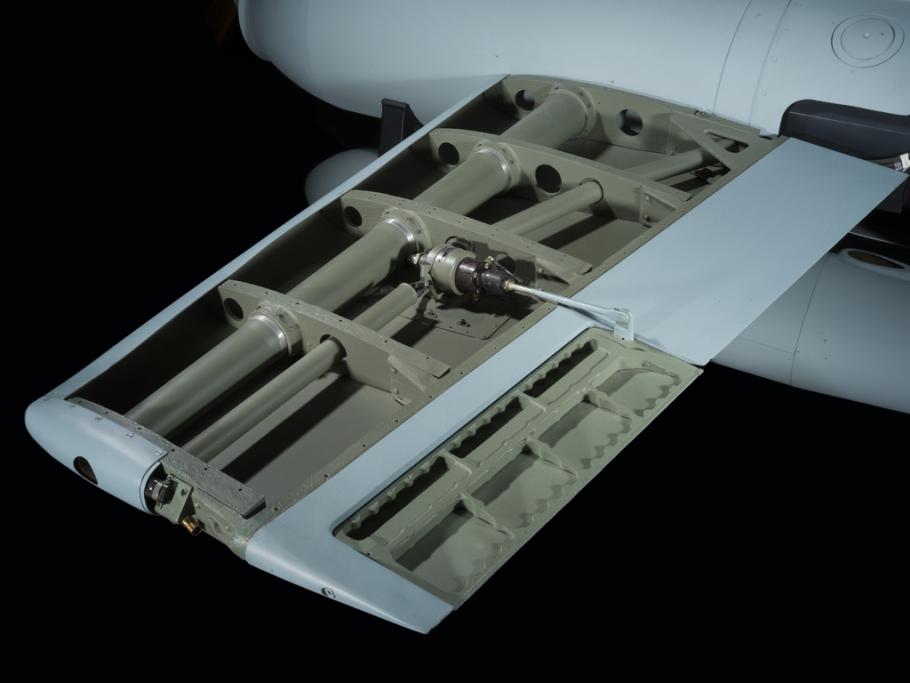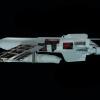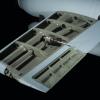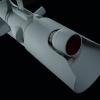Germany developed the Hs 293 air-launched missile in World War II for use against ships or ground targets. It was basically a glide bomb assisted by a liquid-fuel rocket that fired for 10 seconds. The Hs 293 was carried under the wings or in the bomb bay of an He 111, He 177, Fw 200, or Do 217 aircraft. Its warhead was a modified SC 500 bomb containing Trialene 105 high explosive. A bombardier guided the missile by means of a joy stick and radio control.
Beginning in mid-1943, Hs 293s sank several Allied ships, mostly in the Mediterranean theater. Although Germany developed many experimental versions, only the Hs 293 A-1 was produced in quantity.
Description
The missile is constructed mainly of the light alloy duralumin and is a mid-wing monoplane with the rocket motor in a pod hung underneath and the guidance unit in the tail. The propulsion systems is a liquid-propellant motor of 600 kg (1320 lbs.) thrust with a duration of 10 seconds, powered by highly concentrated hydrogen peroxide with a sodium permanganate catalyst.A gyroscopic autopilot controlled the missile, translating the commands received from the launch aircraft into commands to the control surfaces, consisting of ailerons on the wings and an elevator in the tail. The ailerons controlled the bank angle, and were operated by electromagnets, while an elevator operated by a screw and electric motor adjusted the pitch angle. If the Hs 293 was to be used at night, a flare permitted tracking from the parent aircraft. For daytime operations an electric lamp could be substituted. The pilot flew directly at the target at a speed of about 335 km/h (210 mph), dropped the missile and then turned 30 degrees to the left and slowed down. The bombardier constantly monitored the missile's flight, attempting to keep the missile visually on top of the target, and sent commands via a joy stick attached to the "Kehl" transmitter; the missile had a "Strassburg" receiver. Total flight time averaged 55 sec, and maximum speed topped 860 km/h (535 mph) after engine burnout, slowing to 560 km/h (345 mph) during the glide. Wagner's group developed Mach-limiting drag bodies for longer-distance and higher-speed launches so that the missile did not exceed its critical Mach limit; these were never used operationally however.
History
The Henschel aircraft company produced and developed the Hs 293, with Prof. Dr. Herbert Wagner (formerly of Junkers) as the principal designer. At German Air Ministry encouragement, the firm established a missile group in 1939, and in January 1940 Wagner assumed leadership. His group first decided to develop an air-to-ground missile which could be remotely guided to its target. The Hs 293 V2, designed in February 1940, was the first model constructed, the V1 having been abandoned. The Hs 293 V2 had no engine or warhead and was used only for control tests carried out at the Luftwaffenerprobungstelle (Air Force Test Site) Peenemünde-West.
The first version of the missile with an engine, the Hs 293A-0, was launched on 16 December 1940 at Peenemünde, using a solid-fuel 109-515 JATO rocket. These flights did not go well but the missile was gradually improved through extensive testing. During development Wagner and Henschel decided to use a Walter "cold" hydrogen-peroxide engine, the 109-507, for propulsion. Production was ordered as early as November, 1941, mass production began in January 1942, and deliveries made to the Luftwaffe early in 1943, though the development program continued until early 1944. Henschel became the first company to mass-produce guided missiles and the airfoil shaped, which needed to be very precise for proper performance, was controlled during production with the aid of a pioneering digital computer developed by Konrad Zuse.
The Hs 293 first saw combat from Dornier Do 217E-5's on 25 August 1943 against British anti-submarine forces in the Bay of Biscay. Several ships including the corvette Egret were sunk. The Hs 293 was also deployed against Allied ships anchored off the beachhead at Anzio, Italy. Among the other vessels sunk by the Hs 293 were the British destroyers Inglefield, Boadicea, Intrepid, and Dulverton, and the Greek destroyer Vasilissa Olga, as well as numerous escort vessels and transports. The Hs293 was very successful, but over time the inability of the Luftwaffe to protect its bombers, and the increasing sophistication of Allied fighter defenses, made such attacks unacceptably costly for the bomber forces. In the very last stages of the war, some Hs 293s were also fired at land targets, including the Oder river bridges, in order to stop the Soviet advance in the east.
In total, some 30 test models of the Hs 293 are known, some with spoiler controls, smaller wings, improved radio controls, wire guided, and so forth. There were also test models with TV guidance, a solid-fuel rocket-engine version, and others with proximity fuzes, and one meant for faster operation from a jet aircraft (the Arado 234). To prevent jamming, a wire-guided version using the "Dortmund/Duisburg" guidance system was developed under the designation Hs 293B, but eventually all the operational Hs 293 A-1s were equipped to be either radio- or wire-guided; it is not known, however, if any wire-guided missiles were used in combat. A related missile designed to dive underwater and hit ships below the waterline was designated the Hs 293C, which developed into the Hs 294. However, only the Hs 293 A-1 was deployed operationally. The sources disagree on how many were produced; Smith and Kay assert that Henschel produced 1900 test models and Hs 293 A-0s; most of the latter were modified into operational A-1s. Henschel also built several hundred test models of the later development versions and related missiles.
Sources
Th. Benecke and A. W. Quick, eds. History of German Guided Missiles Development: AGARD First Guided Missiles Seminar, Munich, Germany, April, 1956. Brunswick: E. Appelhans, 1957.
Bill Gunston. The Illustrated Encyclopedia of the World's Rockets & Missiles (New York: Crescent Books, 1979), p. 108.
Fritz Hahn. Deutsche Geheimwaffen 1939-1945: Flugzeugbewaffnungen. Heidenheim: Erich Hoffmann, 1963.
Frederick I. Ordway, III and Ronald C. Wakeford. International Missile and Spacecraft Guide (New York: McGraw-Hill Book Co., 1960), pp. 109-111.
J. R. Smith and Anthony L. Kay, German Aircraft of the Second World War (London: Putnam, 1972), pp. 673-678.
Originally written by Frank Winter; extensively revised by Michael Neufeld, September 2000.













